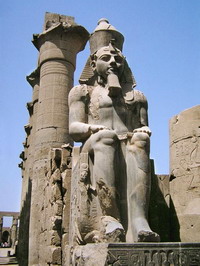Login form
Egypt
 Would you like to see the world’s biggest pyramids? Perhaps you’d enjoy a tour of the desert on a camel? Or maybe you’d like to take a boat ride on the Nile, the longest river in the world? You can do these things and much more in Egypt.
Would you like to see the world’s biggest pyramids? Perhaps you’d enjoy a tour of the desert on a camel? Or maybe you’d like to take a boat ride on the Nile, the longest river in the world? You can do these things and much more in Egypt.
Egypt is a country in northeastern Africa. A small part of Egypt, the Sinai Peninsula, extends into southwestern Asia. Egypt stretches between the Red Sea in the east and the country of Libya in the west. In the north, it touches the Mediterranean Sea.
One of the world’s oldest civilizations started in Egypt, along the banks of the mighty Nile.
|
Facts About Egypt |
|
|
|
|
|
Official name |
Arab Republic of Egypt |
|
Capital |
Cairo |
|
Official language |
Arabic |
|
Population |
76,100,000 people |
|
Rank among countries in population |
15th |
|
Major cities |
Cairo, Giza, Alexandria |
|
Area |
385,000 square miles |
|
Rank among countries in area |
29th |
|
Highest point |
Mt. Catherine |
|
Currency |
Egyptian pound |
THE NILE RIVER
The Nile flows north through Egypt and empties into the Mediterranean Sea. For thousands of years, the Nile overflowed its riverbanks every summer. The floodwaters covered the flooded banks with a rich, dark soil called silt. This made the lands very fertile. People have farmed along the Nile since ancient times.
ASWAN HIGH DAM
Today, dams on the Nile control the yearly flooding. The most famous is the Aswan High Dam. This enormous dam in southern Egypt created Lake Nasser, one of the world’s largest reservoirs.
Water from the dams is used to irrigate crops and make electricity. Because the Nile no longer deposits rich silt along its banks, fertilizers must be used for farming. Important crops include cotton, fruits and vegetables, and sugar.
ANCIENT CIVILIZATION
About 5,000 years ago, the rich farmland along the Nile supported the development of an advanced civilization. The ancient Egyptians built great cities and huge temples to worship their gods. They made beautiful jewelry, fine furniture, and elegant clothes.
The Egyptians invented a kind of picture writing called hieroglyphics. They also made papyrus, a paper-like material, and they wrote some of the first books. Ancient Egypt is sometimes called The Gift of the Nile.
ANCIENT RUINS
Many famous ruins from ancient Egypt still survive today. There are temples filled with statues of gods with animal heads. An enormous statue called the Sphinx crouches in the desert. It has the body of a lion and the head of a human.
Egypt’s most famous ruins are the great pyramids. These massive structures are the tombs of ancient rulers called pharaohs. The museums of Egypt display precious items found in these tombs. People from many countries come to Egypt to see the ruins and relics. Tourism is one of Egypt’s biggest businesses.
THE DESERT
Today, most Egyptians live in the Nile River Valley or on the Mediterranean coast. Most of the rest of Egypt is a vast desert. Temperatures are scorching in the summer. They drop to freezing on winter nights.
There isn’t a lot of wildlife in Egypt because the land is so dry. But foxes, gazelles, jackals, and hyenas roam the desert. Here and there, small springs create fertile patches called oases. In these, farmers grow date palm trees and other crops. The rest of the desert is mostly barren.
AN ARAB COUNTRY
In ad 641, Muslim armies swept into Egypt from Arabia. In 961, Egyptian Arabs founded a powerful empire that lasted almost six centuries. That empire shaped the Egypt of today.
Today, most Egyptians are Arabs. Egypt’s people speak Arabic. Almost all Egyptians are Muslims, or followers of the religion of Islam. Cairo, Egypt’s capital and largest city, is an important center of Arab culture. Cairo has over 7 million people and is growing fast.
Egypt’s many schools include the University of Al-Azhar, one of the world’s oldest universities. It is a center of Islamic learning. Some of the finest Arabic writers are Egyptian.
NASSER’S REVOLUTION
For many centuries, Egypt was controlled by foreign powers. In 1952, an Egyptian army officer named Gamal Abdel Nasser took control of Egypt’s government. Nasser became a hero to many Arabs, and Egypt took a leading role in the Arab world.
PEACE WITH ISRAEL
In 1948, Jewish people living in a region long known as Palestine formed the state of Israel. Egypt joined with other Arab countries in a war to stop Israel’s formation. The war failed. More wars between Arab countries and Israel followed.
In 1979, under President Anwar al-Sadat, Egypt became the first Arab country to sign a peace agreement with Israel. That agreement is still in effect today.
THE SUEZ CANAL
The Suez Canal separates the Sinai Peninsula from the rest of Egypt. The canal runs from the Mediterranean to the Red Sea. It allows ships to sail from Europe to Asia without going all the way around Africa. It is one of the world’s most important waterways.
The canal was built by Europeans and opened in 1869. The Europeans controlled the canal until Nasser came to power. In 1956, Nasser claimed the canal for his country. A war broke out, but Egypt ended up keeping the canal.
Source: Microsoft ® Encarta

